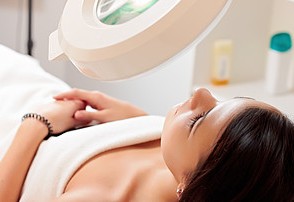Broken capillaries most frequently appear on the face and the legs. On the face, they form a fine pattern of tiny red veins. On the legs, they may look the same as on the face or manifest themselves as blue and greenish veins visible through the surface of the skin.
Erythema appearing on the face and around the neckline can also be vessel-related.
Efektywna terapia może składać się z kilku zabiegów wykonywanych w przeciągu kilku miesięcy (zazwyczaj konieczne jest wykonanie 1-5 zabiegów), a zanik usuwanej zmiany następuje samoistnie.W przypadku zmian naczyniowych naczynia krwionośne stanowią tkankę, która musi być usunięta. Czerwony barwnik krwi pochłania energię świetlną – hemoglobinę. Energia ta przekształca się w ciepło, w wyniku czego podnosi się temperatura krwi. Kiedy ta temperatura jest odpowiednio wysoka, ściana naczynia jest koagulowana i ulega zniszczeniu, w wyniku czego po pewnym czasie jest usuwana przez organizm.
In the case of such vascular lesions the tissue to be destroyed are the blood vessels. The thermal energy is absorbed by the red pigment of blood (hemoglobin) and converted into heat, raising blood temperature. When this temperature is high enough, the blood coagulates and destroys the walls of the vessel, which are in turn removed by the organism after some time.
An effective therapy can consist from several treatment sessions performed in a few month intervals (usually 1-5 sessions are needed), and the lesion fades without any additional efforts.
How does the laser work?
The laser emits light which affects the living tissues. The beam of light has strictly determined parameters and is capable of making changes in the given tissue. The whole procedure is free from the risk of infection and complications.
Lesions and alterations treatable by the procedure:
- flat angiomas,
- cavernous angiomas,
- senile angiomas,
- telangiectasia (dilated small blood vessels on the face or legs),
- poikiloderma (skin damaged by the sun),
- vasodilation (widened veins),
- rosacea.
Counterindications:
- pregnancy,
- taking growth-stimulating medications,
- sensitivity to light,
- tanned skin,
- diabetes,
- taking anticoagulants (medications decreasing blood’s clotting capability),
- coagulation disorders,
- keloids.
Before the treatment
A doctor interviews the patient in order to establish which lesions need to be eliminated. He or she discusses the significance of the procedure with the patient and makes him or her aware of the counterindications.
In the fall and winter season, people with a tendency towards broken blood vessels are recommended to undergo a series of skincare treatments aimed at strengthening and sealing the walls of blood vessels (you can find a detailed description of the treatment under “face cosmetology”).
Only one treatment session is required to remove single, small blood vessels. However, cheeks with a strong reddening and a web of numerous broken vessels may require a few sessions (two or three).
The treatment is virtually painless. When the laser is fired, a slight stinging or burning sensation can be felt.
After the treatment
If the removed blood vessel was big, a bruise, swelling or erythema can appear after the treatment, but it fades after a few hours or days.
The desired effects can be expected within a few months. During this time, control check-ups in 3-6 week intervals are necessary to determine how effective the treatment was, if there were any side effects and if any other treatments are needed.
After the treatment, you also need to refrain from using cosmetics containing retinol and acids. Furthermore, during the first few days it is recommended to avoid physical exercises, massages, hot baths and any situations that run the risk of skin injuries. Try to avoid direct sunlight (do not sunbathe) during the first 4 weeks.

